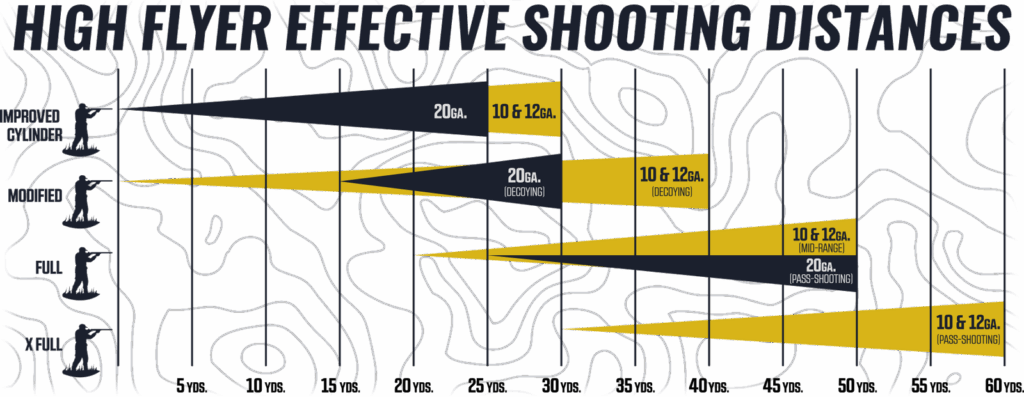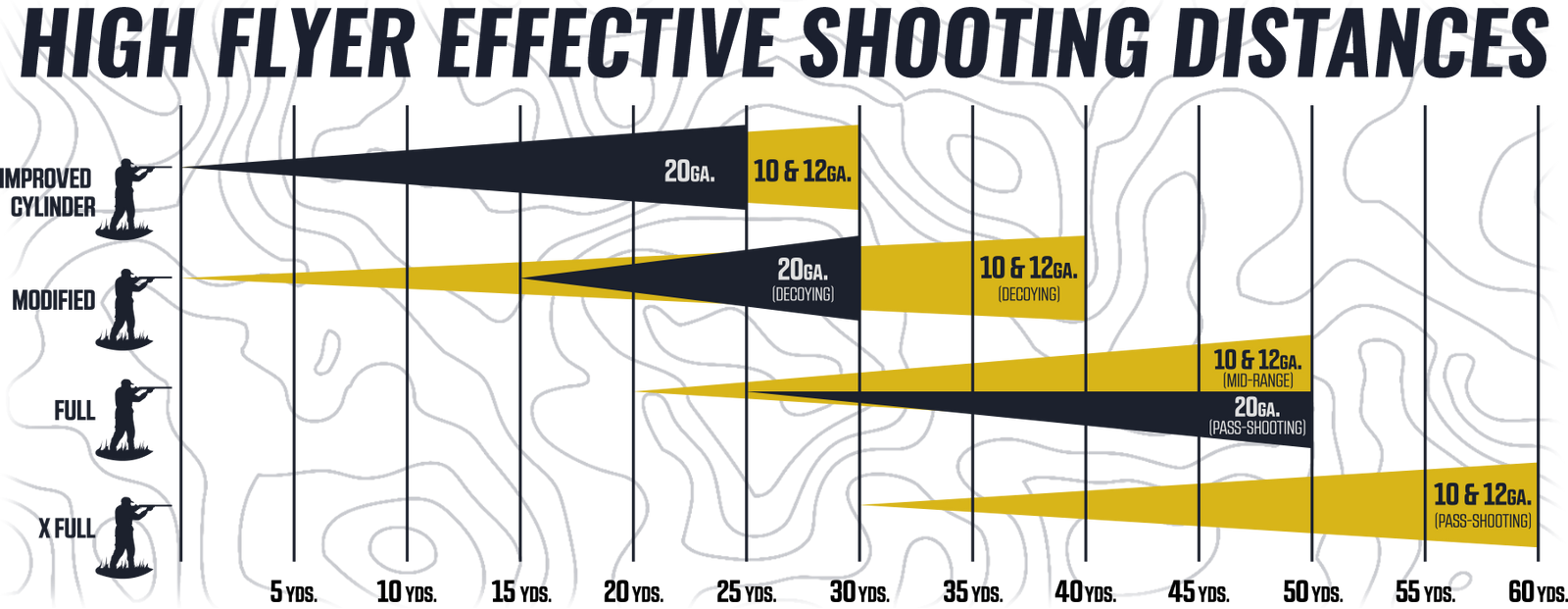
Understanding the Shotgun Choke Chart: A Comprehensive Guide for Shooters
For both seasoned hunters and novice clay shooters, understanding the nuances of a shotgun choke chart is crucial for optimizing performance and achieving consistent results. A shotgun choke isn’t just a piece of metal at the end of your barrel; it’s a precision device that controls the spread of your shot, influencing the pattern and effective range of your shotgun. This guide will delve into the intricacies of shotgun chokes, exploring different types, their intended uses, and how to choose the right choke for your specific shooting needs. This comprehensive guide to shotgun choke charts will equip you with the knowledge you need to make informed decisions and improve your shooting accuracy.
What is a Shotgun Choke?
A shotgun choke is a constriction at the muzzle end of a shotgun barrel that controls the dispersion of the shot as it exits the gun. By varying the degree of constriction, the choke determines how tightly or loosely the shot pattern spreads at different distances. A tighter choke results in a denser pattern at longer ranges, while a more open choke produces a wider pattern ideal for closer targets.
The concept is simple: a tighter choke holds the shot column together for a longer distance, reducing the spread. This is beneficial for long-range shots where a dense pattern is needed to ensure the target is hit. Conversely, a more open choke allows the shot to spread more quickly, creating a wider pattern that is more forgiving at close ranges. This is particularly useful for hunting situations where the target may be moving erratically or appearing suddenly.
Types of Shotgun Chokes
Shotgun chokes come in a variety of constrictions, each designed for specific shooting applications. The most common types are:
- Cylinder (CYL): This choke has no constriction and allows the shot to spread quickly. It’s ideal for very close-range targets (10-20 yards) and is often used for self-defense shotguns.
- Improved Cylinder (IC): Offers a slight constriction, providing a slightly tighter pattern than cylinder. Effective for close to medium-range targets (20-30 yards). A great all-around choice for many hunting scenarios.
- Modified (MOD): A medium constriction that provides a balance between pattern density and spread. Suitable for medium-range targets (30-40 yards). Often considered the best general-purpose choke for hunting and sporting clays.
- Improved Modified (I-MOD): A constriction that falls between Modified and Full. It offers a slightly tighter pattern than Modified, suitable for slightly longer ranges.
- Full (FULL): The tightest standard choke, providing the densest pattern at longer ranges (40+ yards). Best suited for waterfowl hunting or turkey hunting where shots are typically at a distance.
- Extra Full (X-FULL): Even tighter than Full, primarily used for turkey hunting to maximize pattern density at extended ranges.
Beyond these standard chokes, specialized chokes exist for specific purposes, such as rifled chokes for shooting slugs and spreader chokes for creating an extremely wide pattern at very close ranges. Knowing which shotgun choke to use can dramatically improve your shooting success.
Understanding the Shotgun Choke Chart
A shotgun choke chart is a visual representation of the expected shot pattern at various distances for different choke constrictions. It typically shows the percentage of shot that will fall within a 30-inch circle at distances ranging from 20 to 40 yards. This chart helps shooters understand how their chosen choke will perform at different ranges and allows them to select the optimal choke for their intended target.
While shotgun choke charts provide a general guideline, it’s important to remember that actual patterns can vary depending on factors such as the specific shotgun, ammunition, and environmental conditions. Therefore, it’s always recommended to pattern your shotgun with the ammunition you intend to use to confirm the choke’s performance.
Factors Affecting Shot Pattern
Several factors can influence the shot pattern produced by a shotgun choke:
- Ammunition: The type and size of shot, as well as the wad design, can significantly impact the pattern. Different brands and loads may perform differently in the same choke.
- Shotgun Model: Each shotgun has its own unique barrel dimensions and characteristics, which can affect the choke’s performance.
- Distance: As the distance to the target increases, the shot pattern will naturally spread, reducing the density of the pattern.
- Environmental Conditions: Wind and other environmental factors can affect the trajectory of the shot and alter the pattern.
Because of these variables, relying solely on a shotgun choke chart can be misleading. It’s best to use the chart as a starting point and then conduct your own patterning tests to fine-tune your choke selection.
Choosing the Right Shotgun Choke
Selecting the correct shotgun choke depends on the type of shooting you’ll be doing and the typical distances at which you’ll be engaging targets. Here are some general guidelines:
- Close-Range Shooting (10-20 yards): Cylinder or Improved Cylinder chokes are ideal for situations where targets are close and fast-moving, such as upland bird hunting in dense cover.
- Medium-Range Shooting (20-40 yards): Improved Cylinder or Modified chokes are suitable for most hunting and sporting clays applications. They provide a good balance between pattern density and spread.
- Long-Range Shooting (40+ yards): Modified, Improved Modified, or Full chokes are recommended for waterfowl hunting or turkey hunting where shots are typically at longer distances.
For sporting clays, where targets can vary in distance and speed, many shooters use interchangeable chokes to adapt to different stations on the course. Some even use adjustable chokes that allow them to change the constriction without swapping out the choke tube. [See also: Best Sporting Clays Shotgun]
Patterning Your Shotgun
The best way to determine the optimal shotgun choke for your needs is to pattern your shotgun. This involves shooting at a large paper target (typically 30 inches in diameter) at a known distance and then analyzing the resulting shot pattern.
To pattern your shotgun, follow these steps:
- Set up a large paper target at the distance you typically shoot.
- Aim carefully at the center of the target and fire a shot.
- Count the number of pellets that fall within the 30-inch circle.
- Compare the pellet count to the theoretical pellet count for your load and choke.
- Repeat the process several times with different chokes and ammunition to determine the best combination for your needs.
By patterning your shotgun, you can gain valuable insights into how your chosen choke and ammunition are performing and make informed decisions about your equipment. [See also: Shotgun Patterning Techniques]
Aftermarket Shotgun Chokes
While many shotguns come with a set of factory chokes, aftermarket chokes offer a wider range of options and can often improve performance. Aftermarket chokes are available in various materials, constrictions, and designs, allowing shooters to fine-tune their shot patterns to specific needs.
Some popular aftermarket shotgun choke brands include:
- Carlson’s Chokes
- Briley Chokes
- Patternmaster Chokes
- Trulock Chokes
When choosing an aftermarket choke, it’s important to consider the quality of the materials and the precision of the manufacturing. A well-made aftermarket choke can significantly improve your shooting performance.
Shotgun Choke Maintenance
Proper maintenance is essential for ensuring the longevity and performance of your shotgun chokes. After each shooting session, it’s important to clean your chokes to remove any residue or fouling that may have accumulated.
To clean your chokes, follow these steps:
- Remove the choke from the shotgun barrel using a choke wrench.
- Soak the choke in a solvent designed for cleaning firearms.
- Use a choke tube brush to scrub away any residue or fouling.
- Rinse the choke with clean water and dry it thoroughly.
- Apply a light coat of gun oil to prevent rust and corrosion.
- Reinstall the choke in the shotgun barrel, ensuring it is properly tightened.
Regular cleaning and maintenance will help keep your shotgun chokes in good working condition and ensure consistent performance. [See also: Shotgun Cleaning Guide]
Conclusion
Understanding the shotgun choke chart and the different types of chokes available is essential for any shotgun shooter who wants to improve their accuracy and consistency. By choosing the right choke for your specific shooting needs and patterning your shotgun to confirm its performance, you can optimize your shot patterns and achieve better results in the field or on the range. Remember that a shotgun choke chart is a tool, and practical application and experimentation are key to mastery. Don’t be afraid to try different chokes and loads to find what works best for you and your shotgun. With practice and patience, you can become a more proficient and successful shotgun shooter. So, get out there, experiment with different shotgun chokes, and see how they can improve your shooting!

